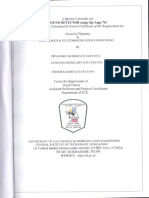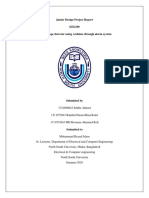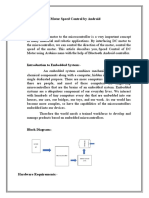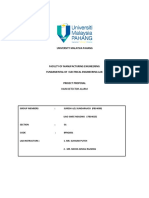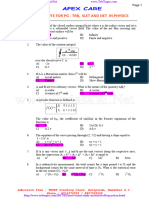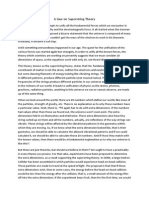Automatic Hand Drier
Automatic Hand Drier
Uploaded by
Peter FavourCopyright:
Available Formats
Automatic Hand Drier
Automatic Hand Drier
Uploaded by
Peter FavourOriginal Description:
Original Title
Copyright
Available Formats
Share this document
Did you find this document useful?
Is this content inappropriate?
Copyright:
Available Formats
Automatic Hand Drier
Automatic Hand Drier
Uploaded by
Peter FavourCopyright:
Available Formats
CHAPTER ONE
1.0
INTRRODUCTION The basic function of a hand dryer is to dry hands using an electric source. Hand hygiene
is a very important aspect in preventing spread of communicable diseases. Since many diseasecaused by germs spread through touch, hand dryers were devised so that people can dry their hands without actually touching the roll of towel available for common use in public restrooms. Hand drying machines not only help in maintaining hygiene, but also help in reducing waste produced by the use of towels. Some years back, these devices were switched on using a button. When the button was pressed, the device started blowing warm air for drying hands. But nowadays hand dryers have infrared motion sensors installed in them. The device detects motion and automatically turns on when hands are placed for drying. Similarly, it automatically turns off when hands are moved away from the dryer, thereby preventing wastage of electricity. Warm air is produced by a hand dryer using a heating coil made up of Nichrome, a hybrid of chromium and nickel. The warm air is then blown out of the device through a tube or a vent facing downwards. Hands are placed in the path of warm air coming out of hand dryer for drying. The warmth and pressure of air coming out of the dryer is sufficient to evaporate water from wet hands. First, the air pressure blows off water droplets from the hands and then the warmth dries out the moisture from the hands. Traditional hand dryers need around 45 seconds to dry hands, whereas new-age dryers take around 15 seconds to do this task.
1.1
STATEMENT OF THE PROBLEM The transmission of bacteria and other micro-organisms is most likely to occur from wet
skin than from dry skin. Careful hand drying is a critical factor determining the level of touchcontact associated bacterial transfer following hand washing. Hence, the proper drying of hands should be an integral component of effective hand hygiene procedures in health care settings. Cloth towel, paper towel and electric air hand dryer are commonly used to dry washed hands. Although there is wide consensus that hand drying is an essential part of hand hygiene process, there is much less consensus regarding the most effective method of hand drying in terms of hand hygiene in health care settings.
1.2.1 SIGNIFICANCE OF THE STUDY
Hand dryers have been popular and more economical in many homes, hand dryers can cut cost by 99.5% (for example a company may spend 500,000 per year on paper towels, where as the hand dryer expenditure would be as low as 30,000 per year. This would vary due to cost of towels .Also, due to the reduction in liter and waste in comparison with towels, which cannot be recycled, hand dryers are also claimed to be better for the environment . Hand dryers are more hygienic compared to a towel. It does not require close contact before it commences its operation neither does it require washing after use.
1.3
OBJECTIVES OF THE STUDY The objective of this project is to construct a machine that will automatically dries up the
wetness of a hand, when those hand are placed before it.
2
1.3.1 SCOPE OF THE STUDY
The automatic hand drier is operated automatically using a sensor called light dependent resistor (LDR). The LDR operates whenever it senses darkness or shadow in the absence of light. The resistance of the LDR is reduced whenever it experiences darkness thereby allowing the flow of electric current through it. Thus, this project is limited to a light dependent resistor, there are other type of sensor used in the modification of an automatic hand drier.
CHAPTER TWO
2.0
LITERATURE REVIEW
George Clemens invented the hand dryer. George Clemens a Chicago nature invented the dryer in 1948. Over the years, the hand dryer as had minimal up-grades but some hand dryers have been up-grade to no touch sensor. Clemens invention eliminated the nud to purchase towels for the customers to dry their hands. In todays society, the hand dryer as still efficient, however, some consider the hand dryer to be not as hygiene as paper towel. George Clemens invention uses a depressed button to operates, which produces more noise while it is pressed ON. (Accessed from www.answers.yahoo.com on 18th of October,2013) In 1991, Mitsubishi engineers set out to develop a solution to traditional hand dryers. With land fill area scares in Japan, an effective hand dryer would significantly reduce waste produced from restrooms and help lessen the environmental impact of hand drying. R and D began testing new ideas for high speed hand drying, discovering that a minimum air speed of 134 is needed to blow water from hands. (Accessed from www.answers.yahoo.com on 18th of October,2013)
In 1993, the first Jet Towel, JT-16A is released after experimenting with more than 50 different prototypes. Operating at 160watts the first Jet Towel introduces the world to the concept of dual-Jet hand drying, but operates at an uncomfortable 71dB. After two years of gathering feedback and testing new ideas, Mitsubishi release 3rd Jet-Towel JT-16c still at 900watts and 65dB, the JT-16c improves operating noise by eliminating high frequency sounds
and improves water flow to drain tank. (Accessed from www.answers.yahoo.com on 18th of October,2013)
The first hand dryers were not as efficient as the current models. Newer hand dryer have infrared sensors and will not run if you do not have your hands under the sensor. This saves energy over former models thus ran on a timer and were often left running after you we finished drying your hands. Newer models also generates stream of air pressure that is higher than former models, which can dry hands in much less time there by requiring less electricity. It was developed by Denis Gagnon and was introduced into market in year 2001.(Accessed from www.exceldryer.com on 18th of October, 2013).
CHAPTER THREE
3.0 3.1.1
COMPONENTS ANALYSIS TRANSFORMER A transformer is a static electromagnetic device that transfers an electrical power from
one circuit to another without change of frequency. It accomplishes this by electromagnetic induction and where the circuits are in mutual inductive influence of each other. A transformer consists of a core and two or more windings coupled electromagnetically. There are primary windings and secondary windings. The winding in which in which energy is delivered is known as the primary winding while the winding to which energy is received is known as the secondary winding. It is shown below.
FIG 3.1 AN IDEAL TRANSFORMER WORKING PRINCIPLE OF A TRANSFORMER A transformer works on the principle of mutual induction between two or more inductively coupled coil .It consists of primary and secondary windings. When the primary winding is energized by sinusoidal voltage, an alternating current flows in the primary winding. The alternating current so produced in the primary winding set up an alternating magnetic flux in
the core .The alternating flux link up the secondary winding thereby inducing e.m.f in the secondary winding. The type of transformer used in this project is a step-down transformer, which steps the voltage from 220v to 12v. 3.1.2 RESISTOR A resistor is an electric component that opposes and impedes the flow of electric current .It is fabricated from a substance that is a poor conductor of electricity, such as carbon or nichromes wires and serves to oppose the flow of electric current in a circuit The type of resistor used in this project is a carbon resistor because of its ability to withstand high energy pulses i.e. when current flows through the resistor, the entire carbon composition body conducts. Resistors also serve the purpose of producing voltage drop and dissipating heat in circuit. A resistor is a passive two terminal electrical component that implements electrical resistance as a circuit element. The current through a resistor is in direct proportion to the voltage across the resistors terminal. This relationship is represented by ohms law, i.e. I=V/R Where I is the current through the conductor in units of amperes is the potential difference measured across the conductor in units of volts and R is the resistance of the conductor in units of ohms .It symbol is shown below.
FIG. 3.2 SYMBOL OF A RESISTOR 3.1.2.1 TABLE SHOWING COLOUR CODE OF RESISTORS COLOUR BLACK BROWN RED ORANGE YELLOW GREEN BLUE VIOLET GREY WHITE GOLD SILVER CODE 0 1 2 3 4 5 6 7 8 9 5% 10%
3.1.3
LIGHT DEPENDENT RESISTOR (LDR) A light dependent resistor also known as photoresistor or photocell is a variable resistor
whose value of resistance decreases with increasing incident light intensity, i.e. it exhibits photoconductivity.
8
A photoresistor is made up of high resistance semi conductor, if light falling on the device is of high frequency, photons absorbed by the semi conductor gives bund electrons enough energy to jump into the conduction band. The resulting free electrons (and its hole partner) conduct electricity, thereby lowering the resistance. The symbol is shown below.
FIG 3.3 SYMBOL OF LIGHT DEPENDENT RESISTOR The variation of the resistance of a LDR with the intensity of the light falling o it is illustrated in the graph below
High RESISTANCE
LIGHT
FIG 3.4 GRAPH SHOWING VARIATION OF RESISTANCE OF LDR WITH LIGHT
3.1.4
INTEGRATED CIRCUIT (IC) An integrated circuit or monolithic is a set of electronic circuit on one plate or chips of
semi conductor material, normally silicon. This can be made much smaller than a discrete circuit made from independent components. Integrated circuit are used in virtually all electronics equipment today and have revolutionized the world electronics. All integrated circuit is capable of producing accurate time base, it can be made to produce one shot (monostable) or free running (astable).the configuration employed in this project is the monostable. All IC rely upon an external capacitor to determine the OFF and ON time interval of the output pulses. Those times are clearly defined and can be calculated given the value of resistance and capacitance. It symbol is shown below.
FIG 3.5 3.1.5
GRAPHICAL SYMBOL OF 555 TIMER
CAPACITOR A capacitor is a device capable of storing electrical energy. In general, a capacitor
consists of two metal plates insulated from each other by a dielectric. The capacitance of a
10
capacitor depends primarily upon the size, shape and relative permittivity of the medium between the plates. Also, they are used to store energy, passes high frequencies and reject low frequencies, produce an a.c voltage drop and to introduce a time delay or phase difference. It takes a finite period of time for a capacitor charge or discharge through a resistor. Assume that the capacitor is initially discharged. When the switch is closed, the capacitor begins to charge through the resistor. The voltage across the capacitor rises from zero up to the value of the applied voltage .The type of capacitor used in this project is the electrolytic capacitor and it is used as a filter in the circuit. It symbol is shown below.
FIG 3.6 SYMBOL OF A CAPACITOR
3.1.6
LIGHT EMITTING DIODE (LED) This is a semi conductor light source which are used as indicator lamps in many
devices and are increasingly used for general lighting. It is a forward biased PN junction which emits visible light when energized. The forward voltage across a LED is considerably greater than silicon PN junction diode. The LED emits light in response to a sufficient forward current. The amount of power output translated into light is directly proportional to the forward current.
11
LED is used for different applications. Before it can be used for a particular application, one or more of the following points have to be considered; wavelength of light emitted, input power required, efficiency, mounting arrangement, light intensity and brightness. It is used as power indicator in this project to show the presence of light in the circuit. It symbol is shown below.
FIG 3.6 A SYMBOL OF LIGHT EMITTING DIODE
3.1.7
TRANSISTOR This is an active semi conductor with three terminals which may be used as an
amplifier, detector or a switch. There are basically two types of a transistor, which are the bipolar junction transistor (BJT) and the field effect transistor (FET). The BJT is used in this project and it is shown below.
FIG 3.7
SYMBOL OF A BIPOLAR JUNCTION TRANSISTOR
12
The terminals labeled B,C and E indicates the base, collector and the emitter respectively. There are two types of bipolar junction transistor (BJT) arrangement and doping of their semi conductor materials. These are the NPN and the PNP type. 3.1.8 DIODE In electronics, a diode is a two terminal electronic component with asymmetric conductance; it has low (ideally zero) resistance to current flow in one direction and high (ideally infinite) resistance in the other. The most common function of a diode is to allow electric current to flow in one direction (called diodes forward direction), while blocking current in the opposite direction (reverse direction). Thus a diode can be viewed as an electronic version of a check valve. This unidirectional behavior is called rectification and is used to convert alternating current to direct current. It symbol is shown below
FIG 3.8
SYMBOL OF A DIODE
13
3.1.9
RELAY A relay is an electrically operated switch. Many relays uses an electromagnet to operate
a switching mechanisms mechanically, but other operating principles are also used. Relays are used where it is necessary to control a circuit by low a power signal (with complete electrical isolation between control and controlled circuit), or where several circuits must be controlled by one signal. A simple electromagnetic relay consists of a coil of wire wrapped around a soft iron core, an iron York which provides a low reluctance path for magnetic flux, a movable iron armature and one or more sets of contacts. When an electric current is passed through the coil, it generates a magnetic field that activates the armature and consequent movement of the movable contacts either makes or breaks (depending upon construction) a connection with a fixed contact. The symbol is shown below
FIG 3.9 3.1.10 HEATING ELEMENT
SYMBOL OF A RELAY
Heating elements are resistive conductors mostly made from nickel, an alloy of iron whose working temperature is around 9500 c and can withstand high temperature for a long period.
14
Below are some of the requirements for a good heating element 1) It must be ductile 2) It must have mechanical strength 3) High specific resistance 4) High oxidizing temperature 5) Low temperature It symbol is shown below
FIG 3.9.1 3.2 ITEM A 1 2 3 B 1 2
SYMBOL OF A HEATING ELEMENT
SPECIFICATION OF MATERIALS DESCRIPTION POWER SUPPLLY TRANSFORMER DIODES CAPACITOR SENSOR STAGE LIGHT DEPENDENT RESISTOR VARIABLE RESISTORS
15
QUANTITY
RATING
1 4 1
220/12 IN4001 4700f
1 1 100k
3 4
TRANSISTOR FIXED RESISTOR
2 5
BC 108 4.7K, 2.2K IK, 2.7K,
C 1 2 3 D 1 2 3 4 5 E
TIMER STAGE RESISTOR CAPACITOR 555 TIMER (I.C) SWITCHING STAGE RESISTOR LIGHT EMITTING DIODE (LED) TRANSITOR DIODE RELAY MOTOR & ATING ELEMENT STAGE 3 1 1 1 1 BC 109 1N4001 12V 10K, 1K, 33K 1 2 1 470K 100f, 0.1f
1 2
FAN HEATING ELEMENT
1 1
220V 40W
FIG 3.9.2
COMPONENTS SPECIFICATION
16
CHAPTER FOUR 4.0 4.1 CONSTRUCTION, TESTING AND PACKAGING THE BLOCK DIAGRAM OF THE SYSTEM In a simple term, a block diagram shows the basic electronic units and functions of a device. The automatic hand drier is made up of five stages, these are as shown below:
POWER STAGE
SENSOR STAGE
TIMER STAGE
SWITCHI NG STAGE
MOTOR ANDELEMENT STAGE
FIG. 4.1 BLOCK DIAGRAM OF THE SYSTEM
4.2
POWER SUPPLY Most electronic devices and circuits require direct voltage power supply .Obtaining direct
voltage is expensive using a battery; hence D.C is obtained from A.C(Alternative current) using the process of verification. The block diagram of a d.c power supply is shown below:-
SOURCE OR MAINS
SMOOTHI NG CIRCUIT
VOLTAGE REGULAT ION
LINE D.C
FIG. 4.2
BLOCK DIAGRAM OF A POWER SUPPLY
17
From the above diagram, the transformer steps down the a.c voltage from 240v to12v a.c. The rectifier converts the a.c voltage to d.c and the process is shown :-
FIG. 4.3
FULLWAVE RECTIFICATION
The type of rectifier used in the circuit is the full wave rectifier. The smoothing circuit minimizes the supply of the output voltage of a rectifier. This is done using capacitors in parallel with a resistive load.
18
4.2.2
SENSORY STAGES This stage consist of light dependent resistor (LDR), variable resistor, fixed value resistor
and transistors .The major component in this stage is the LDR. When the LDR is covered, its resistance increases and low current flows, this leads to a decrease in the voltage drop across the variable resistor (100kw).The base of the transistor (TR1); which is converted to a high current and made to feed the base of the next transistor (TR2) through a resistor. TR2 also converts the high current to give a low collector current, which is below 1/3vce,is sufficient to trigger the pin 2 of the 555 timer in the next stage. The transistor used in this project is a npn bipolar transistor.
FIG 4.4 CIRCUIT DIAGRAM OF THE SENSOR STAGE
19
4.2.3 TIMER STAGE The timer stage is made up of the 555 timer resistor and capacitor. The 555 timer is configured to give one shot (mono stable operation) by connecting external resistor and capacitor to it. The schematic diagram is shown below.
FIG 4.5 MONOSTABLE CONFIGURATION OF 555 TIMER The low voltage from the previous stage triggers the pin 2 of the 555 timer, thus causing the device output to jump to the high level. The resistor and capacitor determine the duration at which the system will remain in the ON state. 4.2.4 SWITCHING STAGE The switching stage comprises of the transistor and resistor, high emitting diode ,rectifier diode and a relay .The voltage from the output of the 555 timer is thereby making the base current of transistor TR3 to be high. A high base current gives a low collector current, which switches ON the relay. The diode connected in parallel to the relay is to prevent reversal of the current diagram is shown below:20
FIG. 4.6 CIRCUIT DIAGRAM OF SWITCHING STAGE 4.2.5 MOTOR AND HEATING ELEMENT STAGE The motor and heating element are connected as shown below .The motor is mounted above the heating element so that as the element heats up, the fan blows hot air from the hand. The diagram is shown below.
FIG. 4.7 COUPLED FAN WITH HEATING ELEMENT
21
4.2.6 CIRCUIT DIAGRAM OF AN AUTOMATIC HAND DRYER
FIG. 4.8 CIRCUIT DIAGRAM OF AN AUTOMATIC HAND DRYER
22
4.3
TESTING Various tests were carried out on the components using multi meter. These tests are as
follows: The transformer was tested to determine its continuity using a multi meter. The rectifier diodes were tested to verify the unidirectional flow of current and its continuity using a multi meter. The transistors were also tested to determine their terminals, types and whether they were good or not using a multi meter. The capacitors were also tested to determine their terminals using a multi meter. The fan was run to ascertain whether it was free from stiffness.
4.3.1 ASSEMBLING All the components used were assembled in an aluminum box. The dimension of the box is 14 x 10 inches. The box is divided into three compartments. The upper compartment houses Vero board, the left compartment houses the squirrel cage fan and the heating element. A circular hole and an exhaust grill are provided beneath the box for the light dependent resistor (LDR) and the heating element. Also, a small hole is provided on the front side for the LED.
4.3.2 TROUBLESHOOTING The following are the common faults that can occur in the hand drier and the actions to be carried out in order to rectify them.
COMMON FAULTS 1 Device not working at all
RECTIFICATION Check the power supply and all the
23
terminal connections. 2. Device not producing heat Check the LDR or the heating element for possible break or relay 3. Fan not rotating Check the fan for stiffness or the relay
4.3.3 1. 2. 3.
GENERAL PRECAUTION Cover construction was made from aluminum for durability All internal parts were plated with corrosion resistance material. Components were mounted in a manner in which hazards such as an open circuit, short circuit, were avoided.
4. 5.
I ensured that IC socket was mounted first and not the 555 timer The heating element is suspended from the aluminum casing to prevent electric shock.
4.3.4
MAINTAINANCE OF THE SYSTEM
1. The hand drier should be kept in a good environment, moist or damp environment should be avoided. 2. Dust should be prevented from the electronic components by cleaning it up with a blower on a monthly basis. 3. When used in an office environment, it should be isolated from power supply after working hours. 4. Any fault should be traced using the circuit diagram of the system.
24
CHAPTER FIVE 5.0 5.1 CONCLUSION AND RECOMMENDATION CONCLUSION The task of construction of the automatic hand drier was challenging and interesting. It can be seen that the described circuit (Automatic hand drier) will operate when a user places his hands in the direction zone and remains there for a short moment, but the drier will not operate for an overly long period of time, which would waste power. Neither would the drier operate in response to momentary or passing signals, but it will shut off if a user momentarily removes his hands from detection zone. The objective of this project work was actually realized.
5.2
RECOMMENDATION The automatic hand drier is recommended for us in academic environments, offices,
hotels, and eateries and residential home. This automatic hand drier is recommended for use in Rectors office. It is also recommended that more research should be carried out on the design and construction of the hand drier so that a reduced size can be achieved.
25
REFERENCE Accessed from www.answers.yahoo.com on 18th of October,2013 Accessed from www.exceldryer.com on 18th of October, 2013 A.K and B.I (2005) A Textbook on Electrical Technology: published by S. Chad & Company Ltd7361,Ram Niger,New Delhi-110055.
26
27
You might also like
- Touch SensorDocument14 pagesTouch SensorAbby SarondoNo ratings yet
- Project Final Report On Home AutomationDocument29 pagesProject Final Report On Home AutomationSubham PalNo ratings yet
- Signal Jammer Project ReportDocument10 pagesSignal Jammer Project ReportAbeer Khan50% (2)
- Design and Construction of A Vehicle Tracking and Accident Alert System Using Gps and GSM ModuleDocument72 pagesDesign and Construction of A Vehicle Tracking and Accident Alert System Using Gps and GSM ModuleJaafar AbbakarNo ratings yet
- Design and Construction of Anti Bag Snatching AlarmDocument11 pagesDesign and Construction of Anti Bag Snatching AlarmHerbert Anision100% (1)
- Design and Construction of A Electronics Trainer KitDocument42 pagesDesign and Construction of A Electronics Trainer KitToheebdareNo ratings yet
- Home Security SystemDocument30 pagesHome Security SystemNjitnum100% (1)
- Smart Blind Stick Using Proteus: Electrical EngineeringDocument44 pagesSmart Blind Stick Using Proteus: Electrical EngineeringRudra PrasadNo ratings yet
- Voice Controlled Home AutomationDocument29 pagesVoice Controlled Home AutomationAbhijit PattnaikNo ratings yet
- Voice Based NoticeDocument9 pagesVoice Based NoticeAnjaliTripathi0% (1)
- Bluetooth Enabled Digital Door Lock Using Arduino-4Document30 pagesBluetooth Enabled Digital Door Lock Using Arduino-4Sunil Choudhary100% (1)
- Antibag Snatch Alarm System PROJECT. - UnlockedDocument23 pagesAntibag Snatch Alarm System PROJECT. - Unlockedchuck254100% (1)
- Ece Project Report Arduino Based Time and Temperature DisplayDocument16 pagesEce Project Report Arduino Based Time and Temperature DisplayAnonymous ytZsBOVNo ratings yet
- Security System For IndustriesDocument26 pagesSecurity System For IndustriesBhavana ShindeNo ratings yet
- Pce Mini Project Report: "RF Transmitter and Receiver"Document9 pagesPce Mini Project Report: "RF Transmitter and Receiver"sumit sanchetiNo ratings yet
- Smart Blind Stick Using Ultrasound DistaDocument55 pagesSmart Blind Stick Using Ultrasound DistaPrasadNooluNo ratings yet
- Mini ProjectDocument6 pagesMini Projectirene0% (1)
- Arduino Uno ProjectDocument17 pagesArduino Uno ProjectDhairya Shah100% (1)
- Thesis Report On Smart Energy MeterDocument12 pagesThesis Report On Smart Energy MeterFida Hussain100% (1)
- Fire Fighting RobotDocument34 pagesFire Fighting RobotAngela ClaritoNo ratings yet
- Ir Music Transmitter and Reciever Project ReportDocument40 pagesIr Music Transmitter and Reciever Project ReportVaddi Vishwanath Kaushik100% (1)
- Power Meter Billing Plus Load Control Using GSMDocument3 pagesPower Meter Billing Plus Load Control Using GSMIJRASETPublicationsNo ratings yet
- Sound Detector Using Op-Amp 741 PDFDocument22 pagesSound Detector Using Op-Amp 741 PDFDãyäñidhï Ñæïk50% (2)
- Wireless Internet SecurityDocument24 pagesWireless Internet SecurityParvathi GoudNo ratings yet
- IoT Smart Home AutomationDocument14 pagesIoT Smart Home AutomationPrincy Sharma0% (1)
- Mobile Phone Detector: A Project ReportDocument30 pagesMobile Phone Detector: A Project Reportkeerthika kNo ratings yet
- Home Automation Using IOT and Mobile AppDocument5 pagesHome Automation Using IOT and Mobile AppAnonymous CUPykm6DZ0% (1)
- Junior Design Project Report EEE299 Gas Leakage Detector Using Arduino Through Alarm SystemDocument45 pagesJunior Design Project Report EEE299 Gas Leakage Detector Using Arduino Through Alarm SystemSabbir Ahmed 1721669No ratings yet
- LDR Project RepoertDocument35 pagesLDR Project Repoertsatvik100% (1)
- Password Based Circuit BreakerDocument16 pagesPassword Based Circuit BreakerEEE GreenCornerNo ratings yet
- Cell Phone Detector Project ReportDocument34 pagesCell Phone Detector Project ReportParamjit Singh75% (8)
- Design and Construction of An InverterDocument18 pagesDesign and Construction of An InverterAdeniji Olusegun43% (7)
- Arduino Based Home Automation System Using Bluetooth Through An Android Mobile PDFDocument72 pagesArduino Based Home Automation System Using Bluetooth Through An Android Mobile PDFsalmanNo ratings yet
- Chapter-I Literature Survey: Department of EceDocument25 pagesChapter-I Literature Survey: Department of EceAnusha RudrarapuNo ratings yet
- Smart Door Lock With Voice Activation and Password Using Arduino UnoDocument11 pagesSmart Door Lock With Voice Activation and Password Using Arduino UnoBEA38ELBadgujar GaneshNo ratings yet
- Gas Detection Project FinalDocument54 pagesGas Detection Project FinalSherry Sher100% (3)
- Iot Based Smart Electricity Meter and Power Theft DetectionDocument6 pagesIot Based Smart Electricity Meter and Power Theft Detectionhamed razaNo ratings yet
- Design of GSM Based Fire Alarm SystemDocument51 pagesDesign of GSM Based Fire Alarm Systemmilkesa100% (1)
- Project Report On Microcontroller Based Traffic Light ControllerDocument22 pagesProject Report On Microcontroller Based Traffic Light ControllerMohitpariharNo ratings yet
- Project Proposal: Arduino Based Home Automation System: ObjectivesDocument1 pageProject Proposal: Arduino Based Home Automation System: ObjectivesAbdul Rahim KhanNo ratings yet
- Projects Related To Electronics CommunicationDocument90 pagesProjects Related To Electronics Communicationkumar_raj_9No ratings yet
- Arduino Based Solar Powered Automatic Handwash SystemDocument13 pagesArduino Based Solar Powered Automatic Handwash SystemAni SibalNo ratings yet
- House Wiring ReportDocument9 pagesHouse Wiring ReportCovid VirusNo ratings yet
- Automatic Room Light Controller With Bidirectional Visitor CounterDocument37 pagesAutomatic Room Light Controller With Bidirectional Visitor Counteramysure150% (2)
- Micro Controller Based Digital Visitor CounterDocument36 pagesMicro Controller Based Digital Visitor CounterThasnim KhanNo ratings yet
- Wireless LCD Via BluetoothDocument39 pagesWireless LCD Via BluetoothAniket Garapati100% (1)
- DC Motor Speed Control by AndroidDocument8 pagesDC Motor Speed Control by AndroidNikhil GaikwadNo ratings yet
- 13.smart Poultry Farm Using Arduino MegaDocument8 pages13.smart Poultry Farm Using Arduino MegavalentinusNo ratings yet
- Theft Detection Based GSM Prepaid Electricity SystemDocument21 pagesTheft Detection Based GSM Prepaid Electricity SystemAkhil TupiliNo ratings yet
- Industrial Automation Using Mobile CommunicationDocument19 pagesIndustrial Automation Using Mobile CommunicationNavila SatheeshNo ratings yet
- PC To PC Communication Using LaserDocument53 pagesPC To PC Communication Using Lasersandarbh588% (8)
- Automatic Hand DrierDocument27 pagesAutomatic Hand DrierEmiola Sunny Day JoshuaNo ratings yet
- Report File EcDocument37 pagesReport File Ecapandey71357No ratings yet
- The Best Electrical Controls Business On The Planet!: Page 1 of 8Document8 pagesThe Best Electrical Controls Business On The Planet!: Page 1 of 8nandiniNo ratings yet
- Electrostatic: TechnologyDocument6 pagesElectrostatic: Technologyelalaoui25No ratings yet
- Building ServicesDocument12 pagesBuilding ServicesEdifice Placement SolutionsNo ratings yet
- Lectura 1 InglésDocument2 pagesLectura 1 InglésMiguel CaballeroNo ratings yet
- Automatic Dustbin YstemDocument3 pagesAutomatic Dustbin YstemsanjuNo ratings yet
- Fee Project PDFDocument5 pagesFee Project PDFsr3shNo ratings yet
- Automatic Room Light ControllerDocument29 pagesAutomatic Room Light ControllerOyadare sarahNo ratings yet
- Reliability EngineeringDocument2 pagesReliability EngineeringPeter FavourNo ratings yet
- LEKAN Project ManagememtDocument8 pagesLEKAN Project ManagememtPeter FavourNo ratings yet
- Basic Principles of Electrical MachinesDocument1 pageBasic Principles of Electrical MachinesPeter Favour80% (5)
- Releasing Your HelperDocument6 pagesReleasing Your HelperPeter FavourNo ratings yet
- Subject Name Subject Code Status Credit Hour Semester/Year Pre-Requisite Teaching Method AssessmentDocument2 pagesSubject Name Subject Code Status Credit Hour Semester/Year Pre-Requisite Teaching Method AssessmentPeter FavourNo ratings yet
- Remember Your God in The Days of Your Youth 1Document5 pagesRemember Your God in The Days of Your Youth 1Peter FavourNo ratings yet
- How To Get Angels To Work For YouDocument3 pagesHow To Get Angels To Work For YouPeter FavourNo ratings yet
- Remember Your God in The Days of Your Youth 1Document5 pagesRemember Your God in The Days of Your Youth 1Peter FavourNo ratings yet
- Auto Hand Drier PRELIMINARY PAGESDocument13 pagesAuto Hand Drier PRELIMINARY PAGESPeter FavourNo ratings yet
- Chapter 8. Wave Motion - Resonance Principle of Superposition of WavesDocument4 pagesChapter 8. Wave Motion - Resonance Principle of Superposition of Wavesdeep34No ratings yet
- Physics 2 Module 2Document4 pagesPhysics 2 Module 2jnnpctngNo ratings yet
- What Is The Difference Between Hydraulic Mean Depth and Hydraulic RadiusDocument1 pageWhat Is The Difference Between Hydraulic Mean Depth and Hydraulic RadiusDeep Debnath0% (1)
- Tnset Physics Study Material 9Document7 pagesTnset Physics Study Material 9NiveCeciliaNo ratings yet
- 7th IAHR 1984 Hamburg Vol 2Document428 pages7th IAHR 1984 Hamburg Vol 2Anonymous ZO1piE3VNo ratings yet
- Archimedes Principle ExplainedDocument2 pagesArchimedes Principle Explainedmajji satishNo ratings yet
- PSCAD For Ppwer QualityDocument2 pagesPSCAD For Ppwer QualityblprasadNo ratings yet
- ELECTRICAL QUESTIONS AND ANSWERS-MCQ-8-ETO - Electro Technical OfficerDocument11 pagesELECTRICAL QUESTIONS AND ANSWERS-MCQ-8-ETO - Electro Technical Officeramit100% (4)
- Force, Work, Power and Energy - Daily Home Assignment 01 - (Victory 2024 - ICSE)Document5 pagesForce, Work, Power and Energy - Daily Home Assignment 01 - (Victory 2024 - ICSE)44 A Ritam BeraNo ratings yet
- UNIT 1-Synchronous Reluctance MotorDocument14 pagesUNIT 1-Synchronous Reluctance MotornirmalpseNo ratings yet
- Engineering Science Module One.Document124 pagesEngineering Science Module One.Yoram BandaNo ratings yet
- Practical Rotordynamics For Centrifugal Pumps 52pp SulzerDocument52 pagesPractical Rotordynamics For Centrifugal Pumps 52pp Sulzer1mmahoney100% (2)
- Method of SlicesDocument29 pagesMethod of SlicesFaran AssifNo ratings yet
- Data Sheet 3VA9988-0AA11: ModelDocument6 pagesData Sheet 3VA9988-0AA11: ModelRurizwan Syahru WibisanaNo ratings yet
- Centrifugal ForceDocument2 pagesCentrifugal Forceroma-ibarreta-7565No ratings yet
- Coursebook Answers Chapter 3 Asal PhysicsDocument3 pagesCoursebook Answers Chapter 3 Asal PhysicsIrina BodeNo ratings yet
- SPG 32-1750 / 32-3500 / Surgeflex 32: Operating ManualDocument39 pagesSPG 32-1750 / 32-3500 / Surgeflex 32: Operating ManualHadi TNo ratings yet
- BS en 1022-2018Document42 pagesBS en 1022-2018Adel A. Abdelaziz100% (1)
- MomentumDocument4 pagesMomentumTahasin KhanNo ratings yet
- Earthing and Bonding of Telecommunication Equipment in Telecommunication Centres PDFDocument22 pagesEarthing and Bonding of Telecommunication Equipment in Telecommunication Centres PDFm3y54mNo ratings yet
- Hartmut Zabel, Michael Farle (Eds.) - Magnetic Nanostructures - Spin Dynamics and Spin TransportDocument278 pagesHartmut Zabel, Michael Farle (Eds.) - Magnetic Nanostructures - Spin Dynamics and Spin TransportMohamad HamdiNo ratings yet
- MasteringPhysics - Assignment 4 - Motion in 2-DDocument4 pagesMasteringPhysics - Assignment 4 - Motion in 2-DStrange Sht100% (1)
- Algebra ExerciseDocument31 pagesAlgebra ExerciseJose Barrera GaleraNo ratings yet
- Superstring TheoryDocument2 pagesSuperstring TheoryRhitam DuttaNo ratings yet
- LabMec PDFDocument39 pagesLabMec PDFEdnna LpNo ratings yet
- Physical Quantities and UnitsCmbDocument22 pagesPhysical Quantities and UnitsCmbManula MuthunayakeNo ratings yet
- Chapter 2 - Newtons Laws of MotionDocument10 pagesChapter 2 - Newtons Laws of MotionRITCHIE LOU CAGULADANo ratings yet
- Physics I: Key Concepts To Remember: Derived Physical Quantities Law of InteractionDocument2 pagesPhysics I: Key Concepts To Remember: Derived Physical Quantities Law of InteractionPrincess jashminNo ratings yet
- Marineflex Yzp 0,6/1 KV: Low Voltage Power Cables 16098Document2 pagesMarineflex Yzp 0,6/1 KV: Low Voltage Power Cables 16098Javier EverestNo ratings yet
- Example 1Document5 pagesExample 1Neda SpasojevićNo ratings yet






















